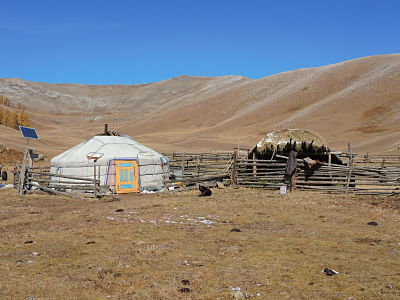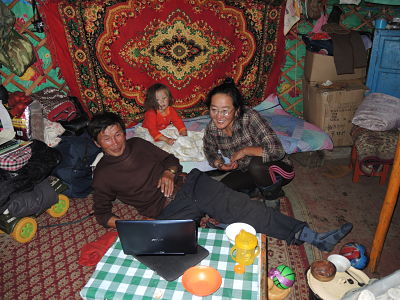Thanks to the fantastic research of our partner school classes we were able to learn even more during our Sustainability Adventure in Mongolia. Via powerpoint presentations and WordPress blogs that they made themselves they answered our questions and provided us with important information about Mongolia and the demographic and energy-situation there.
Click on the following thumbnails to visit the students’ blogs and – like us – learn more.
It was also very helpful to discuss our questions with our partner classes in the USA and Austria, in order to learn more about what kinds of energy require raw natural resources, which do not, and what the consequences can result from the exploitation of the individual natural resources. Whereas coal and uranium are pulled out of the ground at huge mines in Mongolia for the generation of energy in coal and nuclear power plants (mostly abroad), the students used demographic and climate data to reach the conclusion that wind and solar energy would make most sense to use to generate electricity in Mongolia. And they weren’t far off the mark! At least compared to our observations while traveling through the Mongolian steppe: Almost every yurt in the countryside (traditional home – see picture) was equipped with a small solar panel. Since many of the yurts are a half-day ride away from each other, the UN thought that decentralized, autonomous electricity generation by way of solar energy could be perfect for the nomadic lifestyle of many Mongolians, and – like many Mongolians told us – the UN organized small solar panels for almost every family in the countryside. In that way they didn’t need to lay any power lines and yet there is electricity in the evenings for light and the telephone. Even we took advantage of this and were able to watch a silent movie with our host family in their yurt one evening on our tablet (see picture below).
was equipped with a small solar panel. Since many of the yurts are a half-day ride away from each other, the UN thought that decentralized, autonomous electricity generation by way of solar energy could be perfect for the nomadic lifestyle of many Mongolians, and – like many Mongolians told us – the UN organized small solar panels for almost every family in the countryside. In that way they didn’t need to lay any power lines and yet there is electricity in the evenings for light and the telephone. Even we took advantage of this and were able to watch a silent movie with our host family in their yurt one evening on our tablet (see picture below).
We even spied a windmill farm a little outside of the capital city. So you were right. Of course coal is also used quite a bit for heating and for the generation of electricity so that there is enough energy available for the rapidly growing capital.
But does only Mongolia use the massive amounts of resources being mined there? Definitely not! As our school classes correctly pointed out, there are only about 2.9 million Mongolians and the average Mongolian uses only 1.338 kWh per year (compared to 7,758 kWh/year by the average Austrian and 12,186 kWh/year by the average American). And we saw firsthand during our trip through the country that at least the rural population in Mongolia lives very simply and sufficiently from their herds. Their yurts are heated with the dried dung from their animals and wood, and while we were volunteering with two different (nomadic) Mongolian families we even got to collect some dung and chop firewood ourselves.
But then why is mining booming in Mongolia and who is doing the mining?
To find that out we met up with Nicola Imoli, an Italian anthropologist conducting research in the capital of Mongolia, Ulan Bator, and he was able to tell us a little about how the situation is for local people living near the mines. For his research he spent time with local nomads in the middle of one of the largest mining areas in Mongolia and learned much about who operates the mines, what they are extracting, and how this mining activity impacts the local Mongolian people.
Our conclusion: Because it is their living space that is being changed drastically as a result of the extraction of resources, there was less reason for us to worry on our journey through southern Mongolia than for the people living there and therefore directly affected.
In the following edited interview with Nicola you can hear more about how much the Mongolians’ lives have been changed and what – at times surprising – issues the mining activities raise for the local people.
Thankfully, Nicola could also give us some good news: The local people have been able to make their voices heard by joining together. We had the opportunity to interview the executive director of Mine Watch Mongolia, Sukhgerel Dugersuren, by email. You can read a little about some of the biggest challenges and her greatest wishes and vision for a more sustainable future for Mongolia in the short interview here (download PDF).



